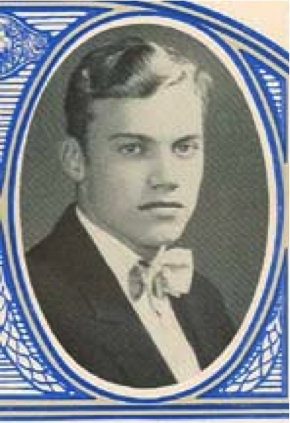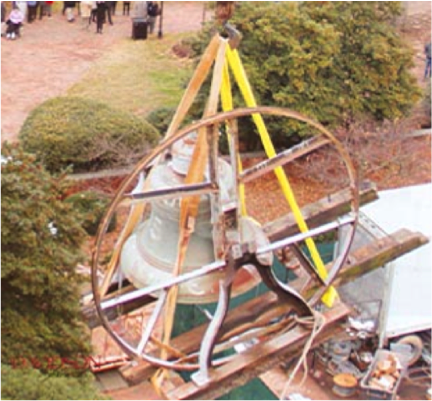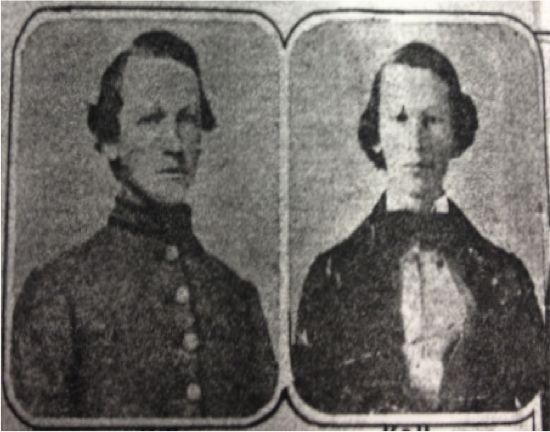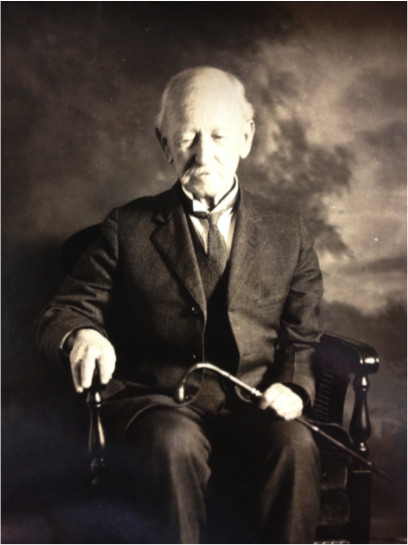Back to College Letters Collection
Jump to Original | Jump to Annotations | Jump to Works Cited
From: DC0153s. Stringfellow, John James, 1857-1931 (1860) Collection, 1858-1930. (View Finding Aid)
Transcript
126 York St.
Chester. S.C.
June 28th 1930
My Dear Chalmers [1],
I am pleased at receiving your letter and will answer at once. I entered Davidson in the spring of 1857 freshman, half advanced and graduated in 1860 [2]. I found Davidson a very quiet place and very orderly students [3] – as for dwelling [or any] ill will between students, I never heard of such, but I did hear reports of the boys teasing the Professors [4] by taking a goat to the roof of the building and tying it to the bell rope [5] which created quite a commotion, but just who played this practical joke was never found out.
There was one occurrence that happened early in the term, before my arrival. It seems that some man living about three miles from the college had committed some act that displeased some of the boys, they thinking he would not be sufficiently punished took the law in their own hands and [offer] receiving the case in private conclave, they decided that he was guilty of the charge and deserved a cost of tar and feathers accordingly [6]. They removed his clothes, smeared his body with soft tar and then applied the feathers and sent him home in this sad plight. The next morning, a youth of some twelve years, appeared on the campus and around the buildings hallooing – “Who tarred Dad?”, he was sent away without expl[i]nations – some mystery shrouded all this and it was only whispered around, and hastily sank in oblivion – Davidson College at that time was totally dry and had a love for bidding any liquor being brought within a radius of two miles of the college on penalty of immediate expulsion [7].
Your friends in Chester are all well. The town is very sad over the sudden death of young Mrs. Ed Hemrich who was buried today. Dr. Shepperson [8] coming to assist Mr. Mann in the service. I am glad that you and your mother are having a happy time this summer. Hop[e]ing that this good report of young Davidson will be pleasing.
Yours,
Uncle John.
J.J. Stringfellow
Original
Jump to top
Annotations
Jump to top

[1] John Stringfellow, a Davidson College Alumnus (Class of 1860), was writing to Chalmers Davidson recalling some of his college experiences seventy years after graduating. Chalmers Davidson, also from Chester, South Carolina, began his collegiate career at Davidson College, graduating in 1928. He then attended Harvard and The University of Chicago. In 1836, he returned to Davidson College (known as “Dr. D”) where he taught history and served as Director of the Library from 1836-1976. After retiring, he became a college archivist and professor emeritus.
For more information see: https://davidsonarchivesandspecialcollections.org/archives/encyclopedia/chalmers-davidson
[2] In Stringfellow’s first year at Davidson, there were only 36 students in his class, and 99 in total at the college (DCC 6-10). In his senior year, he excelled in his academics (Chemistry in particular with a grade of 93 – he became a druggist and doctor in later years) (1860 Faculty Minutes pp. 195).
In the late 19th century, Davidson College academic school years, semesters, and vacations were quite different than they are today. The 1857 academic school year ended on July 16th. There were two sessions. There was a Christmas break of two weeks and each session ended with final exams. In 1858 the academic school year ended on July 15th. In 1859 the academic school year ended July 14th. In 1861 the academic school year ended on July 11th. There was a two week recess including Christmas and New Year. The Senior class exams were five weeks before commencement. The Davidson College Archives have no catalogs for the year 1860 as well as the years 1863-1865 (DCC 10-15).
[3]Students were known to be very orderly. They had been required to work “on the college farm and otherwise assist in the tasks connected with the upbuilding of the physical plant of the institution” (Charlotte Observer). During Stringfellow’s time at Davidson, he recalled only one instance where faculty had to intervene to discipline students, which was the incident of the college bell ringing, “disturbing the peace of the campus” (Charlotte Observer). However, while Stringfellow speaks so confidently, his recollection conflicts with other sources, including Mary Beaty’s A History of Davidson College.
[4]Incidents like this often happened during this time period. In Mary Beaty’s A History Of Davidson College, she writes of students taking “the large campus bell from its place near the Chapel and rang it all one night in November 1859, warding off faculty recovery raids with rocks and clubs” (Beaty 98). Also, according to “Davidson College Faculty Minutes”, on January 4th, 1860, “the Bursar was authorized to have a new lock put on the door of the bell-ringer, as certain keys of other rooms had been found to unlock it, and the bell rung irregularly” (1860 Faculty Minutes pp. 193).

[5] The Davidson College bells have had an interesting history. Over the course of the 19th and 20th century, the bells have evolved with respect to the changing time periods. The bells called students to meals, chapel, pointed out significant times of the day, and signaled the end of classes. The bells were placed on top of chambers, so that they could be heard all over campus. The first large bell on top of chambers was installed in 1860. The students often misplaced the bells in order to irritate the faculty. In 1859, when Smith and his friends were accused of moving the bell as a prank, the Buie brothers, like Smith, wrote home assuring their family they were not involved. The pranksters rang the bell all night after its move in November 1859. The students threw rocks and clubs at the faculty when they tried to recover it. The pranksters actually said, “the faculty don’t act like gentlemen so why should I?” If caught, punishments for moving the bells were harsh and could even result in expulsion. The earliest Davidson college bell was recently found buried under a barn on a local Davidson property and returned to the school (Beaty’s “A History of Davidson College”).
[6] There were some instances of students interacting with locals in a disorderly manner – fighting etc. (Students also liked to blame locals for their own wrongdoings). But this particular source cannot be found.
[7] Stringfellow in the 1928 Charlotte Observer: “During all my four years at Davidson College, I didn’t once hear an oath or epithet fall from the lips of a fellow student. I have no recollection of ever seeing one of my college-mates in a state of intoxication. There was certainly no drinking of liquors on the campus. A college regulation, which was later enacted into a town ordinance, made it a misdemeanor to bring or to possess intoxicants within a two-mile radius of the college campus” (Charlotte Observer). While Stringfellow recalls almost flawless student behavior, the Davidson Faculty Minutes during his time accounted of several incidents that suggested otherwise.
[8] Possibly Flournoy Shepperson, a Minister of the Presbyterian Church. Spent time in Chester, South Carolina from 1921-25, and it is likely that he may have come back for the service of Mrs. Hemrich’s funeral (Ministerial Directory).
John James Stringfellow (June 16, 1837- March 5, 1931 (93)) attended Davidson College from 1857 to 1860. He resided in Chester, South Carolina, and remained there until his death. At Davidson, Stringfellow was also one of the eight original members of the one of the first societal fraternities on campus, Chi Phi. He also fought in the Civil War as a Confederate soldier (he was first wounded in the Battle of Seven Pines as well as the Battle of Petersburg). Following this, according to The Charlotte Observer of 1928, Stringfellow was “the proprietor of a lucrative drug business in the flourishing little city of Chester”, where he served as a doctor and a druggist (Charlotte Observer). In retirement, he continued his large farming operations six miles east of Chester.


Works cited
Jump to top
Beaty, Mary. A History of Davidson College. Briarpatch Press: Box 148 Davidson, North Carolina, 1988. Print.
Branch, Harley. “Chester Claims Oldest Living Graduate of Davidson.” The Charlotte Observer. 1 Apr. 1928: 4. Print.
Davidson College. Digital Dickinson. Davidson College Archives & Special Collections, n.d. Web. 2 May 2014.
https://davidsonarchivesandspecialcollections.org/archives/encyclopedia/chalmers-davidson
Davidson College Catalogue: 1857. Fayetteville: Presbyterian Job-Office, 1857: 6-10. Print.
Davidson College Catalogue: 1859. Fayetteville: Presbyterian Job-Office, 1859: 10-15. Print.
Davidson College Faculty Minutes 1842-1873. 4 January 1860. RG 2/3.2 Presidents Office. Davidson College Archives. Davidson, NC.
Scott, Rev. E. C. Ministerial Directory of the Presbeterian Church, U.S. 1861-1941. Order of the General Assembly. Austin, Texas: Press of Von Boeckmann-Jones Co., 1942. Print.
Photograph of Chalmers Davidson – https://davidsonarchivesandspecialcollections.org/archives/encyclopedia/chalmers-davidson
Photograph of the college bell – https://davidsonarchivesandspecialcollections.org/archives/encyclopedia/bells
Photograph of John Stringfellow – The Charlotte Observer. 1 Apr. 1928: 4.
Photograph of John Stringfellow – RG 5/8.1 Stringfellow. Alumni File. Davidson College Archives. Davidson, NC.
Transcription and annotation authors: Annie Brockett, Jonathan Ferguson & Max Pragnell.
Date: May 2014.
Cite as: Brockett, Annie, Jonathan Ferguson, and Max Pragnell. 28 June 1930 John Stringfellow Letter. DC0153s.
Available: https://davidsonarchivesandspecialcollections.org/archives/digital-collections/j-j-springfellow-letter-18-june-1930.

Sorry, comments are closed for this post.